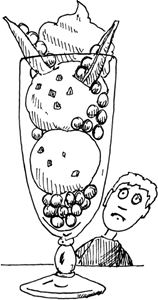Line graphs and bar charts aren’t always the most effective way to show data. If you need to show the relationship between different sets of data, a Venn diagram is useful. It was named after John Venn, who came up with the idea in 1880, and consists of overlapping circles, showing different sets of data. The area where the circles overlap represents what the two sets of data have in common.
Give Peas A Chance
If you asked 20 friends if they like ice cream and if they like peas, you could put the results into a Venn diagram according to what they say. In this example, 18 friends have said they like ice cream – only eight like peas as well, and the last two like peas, but not ice cream:


Circle A shows the friends who like ice cream. Circle B shows the friends who like peas.
Area C, where the circles overlap, shows the people who like both ice cream and peas – they are common to both sets.
An inventor named Professor X has created a robot – he hopes that it will be extremely popular. Gizmoid can play football and tennis and look after your pet dog while you’re at school. It seems like a brilliant idea – football and tennis are very popular, and lots of people have a dog.
To make sure, Professor X does a survey, asking 100 people if they play football or tennis, and if they have a dog. His data shows that 54 people like playing football, 32 play tennis and 46 are dog-owners. Only 3 people don’t like football or tennis and don’t own a dog.
This sounds very promising, but what’s really useful about Venn diagrams is that they can show the relationship between more than two sets of data. If someone doesn’t like any of the three things, they are shown outside the circles. So Professor X uses one to see how popular Gizmoid will be.

Straightaway, Professor X can see the number of people who share each preference.
So, out of the 100 people Professor X surveyed, only one could make full use of Gizmoid!